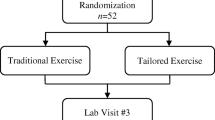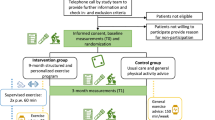Abstract
Background
Fatigue is the most common and disabling symptom affecting quality of life (QOL) and daily function in patients who have completed treatment for acute myeloid leukemia (AML). Although trials in patients with various solid tumors have reported improved fatigue and QOL following exercise interventions, there have been no studies in AML patients post treatment.
Methods
Forty patients aged ≥40 years who had completed treatment for AML were enrolled in a 12-week randomized phase II exercise intervention to determine feasibility (recruitment, retention, and adherence), efficacy, and safety of the intervention. Patients assigned to the exercise group received an individualized, moderate-intensity, 12-week home-based exercise program with weekly telephone support from a certified exercise physiologist. QOL, fatigue, and fitness outcomes were measured at baseline, 6 weeks, and 12 weeks. Between-group differences in 12-week change scores were calculated using linear regression adjusting for age and baseline function.
Results
Recruitment and retention rates were 38 % and 91 %, respectively. Adherence was low at 28 %. Analyses did not suggest statistically significant or clinically important benefits in QOL, fatigue, or physical fitness with the intervention. The level of adherence did not appear to impact outcomes. There were no adverse events.
Conclusion
A home-based exercise program for post-treatment AML patients age 40 years or older can be safely delivered with reasonable recruitment and high retention. However, feasibility was hampered by low adherence. Further research and program modification are needed to better understand and overcome barriers to exercise delivery and adherence in AML survivors.

Similar content being viewed by others
References
Aaronson NK, Ahmedzai S, Bergman B, Bullinger M, Cull A, Duez NJ, Filiberti A, Flechtner H, Fleishman SB, de Haes JC et al (1993) The European Organization for Research and Treatment of Cancer QLQ-C30: a quality-of-life instrument for use in international clinical trials in oncology. J Natl Cancer Inst 85:365–376
Alibhai SM, Leach M, Kowgier ME, Tomlinson GA, Brandwein JM, Minden MD (2007) Fatigue in older adults with acute myeloid leukemia: predictors and associations with quality of life and functional status. Leukemia 21:845–848
Alibhai SM, Leach M, Minden MD, Brandwein J (2009) Outcomes and quality of care in acute myeloid leukemia over 40 years. Cancer 115:2903–2911
Alibhai SMH, Leach M, Gupta V, Tomlinson GA, Brandwein JM, Saiz FS, Minden MD (2009) Quality of life beyond 6 months after diagnosis in older adults with acute myeloid leukemia. Crit Rev Oncol Hematol 69:168–174
Alibhai SMH, Leach M, Kermalli H, Gupta V, Kowgier ME, Tomlinson GA, Brandwein J, Buckstein R, Minden MD (2007) The impact of acute myeloid leukemia and its treatment on quality of life and functional status in older adults. Crit Rev Oncol Hematol 64:19–30
Baumann FT, Zopf EM, Bloch W (2012) Clinical exercise interventions in prostate cancer patients—a systematic review of randomized controlled trials. Support Care Cancer 20:221–233
Bruera E, Kuehn N, Miller MJ, Selmser P, Macmillan K (1991) The Edmonton Symptom Assessment System (ESAS): a simple method for the assessment of palliative care patients. J Palliat Care 7:6–9
Canadian Society of Exercise Physiology (2002) Physical activity readiness questionnaire. Canadian Society of Exercise Physiology, Ottawa
Canadian Society of Exercise Physiology (2011) Canadian physical activity guidelines. Health Canada, Ottawa
Carron AV, Hausenblas HA, Mack D (1996) Social influence and exercise: a meta-analysis. J Sport Exerc Psychol 18:1–16
Cella D, Lai JS, Chang CH, Peterman A, Slavin M (2002) Fatigue in cancer patients compared with fatigue in the general United States population. Cancer 94:528–538
Charlson ME, Pompei P, Ales KL, MacKenzie CR (1987) A new method of classifying prognostic comorbidity in longitudinal studies: development and validation. J Chron Dis 40:373–383
Courneya KS, Friedenreich CM (1997) Relationship between exercise pattern across the cancer experience and current quality of life in colorectal cancer survivors. J Altern Complement Med 3:215–226
Courneya KS, Friedenreich CM, Sela RA, Quinney HA, Rhodes RE, Handman M (2003) The group psychotherapy and home-based physical exercise (group-hope) trial in cancer survivors: physical fitness and quality of life outcomes. Psychooncology 12:357–374
Culos-Reed SN, Robinson JL, Lau H, O'Connor K, Keats MR (2007) Benefits of a physical activity intervention for men with prostate cancer. J Sport Exerc Psychol 29:118–127
Culos-Reed SN, Robinson JW, Lau H, Stephenson L, Keats M, Norris S, Kline G, Faris P (2010) Physical activity for men receiving androgen deprivation therapy for prostate cancer: benefits from a 16-week intervention. Support Care Cancer 18:591–599
Dalal HM, Zawada A, Jolly K, Moxham T, Taylor RS (2010) Home based versus centre based cardiac rehabilitation: Cochrane systematic review and meta-analysis. BMJ 340:b5631
Dimeo F, Bertz H, Finke J, Fetscher S, Mertelsmann R, Keul J (1996) An aerobic exercise program for patients with haematological malignancies after bone marrow transplantation. Bone Marrow Transplant 18:1157–1160
Fong DY, Ho JW, Hui BP, Lee AM, Macfarlane DJ, Leung SS, Cerin E, Chan WY, Leung IP, Lam SH, Taylor AJ, Cheng KK (2012) Physical activity for cancer survivors: meta-analysis of randomised controlled trials. BMJ 344:e70
Godin G, Shephard RJ (1985) A simple method to assess exercise behavior in the community. Can J Appl Sport Sci 10:141–146
Heyward VH (2010) Advanced fitness assessment and exercise prescription. Human Kinetics Publishers, Windsor
Hopwood P (1992) Progress, problems and priorities in quality of life research. Eur J Cancer 28A:1748–1752
Jacobs DR Jr, Ainsworth BE, Hartman TJ, Leon AS (1993) A simultaneous evaluation of 10 commonly used physical activity questionnaires. Med Sci Sports Exerc 25:81–91
Janssen KJ, Donders AR, Harrell FE Jr, Vergouwe Y, Chen Q, Grobbee DE, Moons KG (2010) Missing covariate data in medical research: to impute is better than to ignore. J Clin Epidemiol 63:721–727
Katzmarzyk PT, Leon AS, Wilmore JH, Skinner JS, Rao DC, Rankinen T, Bouchard C (2003) Targeting the metabolic syndrome with exercise: evidence from the HERITAGE Family Study. Med Sci Sports Exerc 35:1703–1709
Lemmink KA, Kemper HC, de Greef MH, Rispens P, Stevens M (2003) The validity of the sit-and-reach test and the modified sit-and-reach test in middle-aged to older men and women. Res Q Exerc Sport 74:331–336
Mathiowetz V, Kashman N, Volland G, Weber K, Dowe M, Rogers S (1985) Grip and pinch strength: normative data for adults. Arch Phys Med Rehabil 66:69–74
Osoba D, Rodrigues G, Myles J, Zee B, Pater J (1998) Interpreting the significance of changes in health-related quality-of-life scores. J Clin Oncol 16:139–144
Pinto A, Zagonel V, Ferrara F (2001) Acute myeloid leukemia in the elderly: biology and therapeutic strategies. Crit Rev Oncol Hematol 39:275–287
Schmitz KH, Courneya KS, Matthews C, Demark-Wahnefried W, Galvao DA, Pinto BM, Irwin ML, Wolin KY, Segal RJ, Lucia A, Schneider CM, von Gruenigen VE, Schwartz AL (2010) American College of Sports Medicine roundtable on exercise guidelines for cancer survivors. Med Sci Sports Exerc 42:1409–1426
Schmitz KH, Holtzman J, Courneya KS, Masse LC, Duval S, Kane R (2005) Controlled physical activity trials in cancer survivors: a systematic review and meta-analysis. Cancer Epidemiol Biomarkers Prev 14:1588–1595
Schumacher A, Kessler T, Buchner T, Wewers D, van de Loo J (1998) Quality of life in adult patients with acute myeloid leukemia receiving intensive and prolonged chemotherapy — a longitudinal study. Leukemia 12:586–592
Schumacher A, Wewers D, Heinecke A, Sauerland C, Koch OM, van de Loo J, Buchner T, Berdel WE (2002) Fatigue as an important aspect of quality of life in patients with acute myeloid leukemia. Leuk Res 26:355–362
Sevick MA, Miller GD, Loeser RF, Williamson JD, Messier SP (2009) Cost-effectiveness of exercise and diet in overweight and obese adults with knee osteoarthritis. Med Sci Sports Exerc 41:1167–1174
Sim J, Lewis M (2012) The size of a pilot study for a clinical trial should be calculated in relation to considerations of precision and efficiency. J Clin Epidemiol 65:301–308
Singh MA (2002) Exercise comes of age: rationale and recommendations for a geriatric exercise prescription. J Gerontol A Biol Sci Med Sci 57:M262–M282
Solway S, Brooks D, Lacasse Y, Thomas S (2001) A qualitative systematic overview of the measurement properties of functional walk tests used in the cardiorespiratory domain. Chest 119:256–270
Spring B, Schneider K, McFadden HG, Vaughn J, Kozak AT, Smith M, Moller AC, Epstein LH, Demott A, Hedeker D, Siddique J, Lloyd-Jones DM (2012) Multiple behavior changes in diet and activity: a randomized controlled trial using mobile technology. Arch Intern Med 172:789–796
Stalfelt AM (1994) Quality of life of patients with acute myeloid leukaemia. Leuk Res 18:257–267
Taylor RS, Brown A, Ebrahim S, Jolliffe J, Noorani H, Rees K, Skidmore B, Stone JA, Thompson DR, Oldridge N (2004) Exercise-based rehabilitation for patients with coronary heart disease: systematic review and meta-analysis of randomized controlled trials. Am J Med 116:682–692
Wagner LI, Cella D (2004) Fatigue and cancer: causes, prevalence and treatment approaches. Br J Cancer 91:822–828
Walker J, Postma K, McHugh GS, Rush R, Coyle B, Strong V, Sharpe M (2007) Performance of the hospital anxiety and depression scale as a screening tool for major depressive disorder in cancer patients. J Psychosom Res 63:83–91
Watson T, Mock V (2004) Exercise as an intervention for cancer-related fatigue. Phys Ther 84:736–743
Wiskemann J, Dreger P, Schwerdtfeger R, Bondong A, Huber G, Kleindienst N, Ulrich CM, Bohus M (2011) Effects of a partly self-administered exercise program before, during, and after allogeneic stem cell transplantation. Blood 117:2604–2613
Yellen SB, Cella DF, Webster K, Blendowski C, Kaplan E (1997) Measuring fatigue and other anemia-related symptoms with the Functional Assessment of Cancer Therapy (FACT) measurement system. J Pain Symptom Manage 13:63–74
Author information
Authors and Affiliations
Corresponding author
Rights and permissions
About this article
Cite this article
Alibhai, S.M.H., O’Neill, S., Fisher-Schlombs, K. et al. A pilot phase II RCT of a home-based exercise intervention for survivors of AML. Support Care Cancer 22, 881–889 (2014). https://doi.org/10.1007/s00520-013-2044-8
Received:
Accepted:
Published:
Issue Date:
DOI: https://doi.org/10.1007/s00520-013-2044-8




